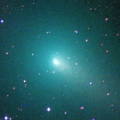
|
Now it is bright as 9.2 mag (Nov. 2, Maik Meyer). In the Northern Hemisphere, it stays observable in excellent condition for a long time. In the Southern Hemisphere, it will never be observable again after this. It started fading before the peirhelion passage.
Date(TT) R.A. (2000) Decl. Delta r Elong. m1 Best Time(A, h)
Nov. 11 4 50.89 77 11.7 0.804 1.546 118 9.1 1:33 (180, 48)
Nov. 18 4 34.66 81 29.4 0.851 1.573 117 9.3 0:51 (180, 44)
|
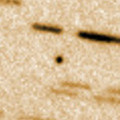
|
It brightened up to 11.6 mag in mid October (Oct. 13, Chris Wyatt). It passed the perihelion on Oct. 27. It will not be observable after this.
Date(TT) R.A. (2000) Decl. Delta r Elong. m1 Best Time(A, h)
Nov. 11 15 41.92 -7 33.2 1.438 0.528 13 10.2 18:24 ( 84, -5)
Nov. 18 16 14.79 -9 46.9 1.629 0.709 13 12.0 18:20 ( 81, -4)
|
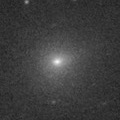
|
Now it is 11.4 mag (Nov. 3, Thomas Lehmann). It is fainter than this ephemeris recently. It stays 11 mag until December. It is observable in good condition in the Northern Hemisphere. It locates very low for a long time in the Southern Hemisphere.
Date(TT) R.A. (2000) Decl. Delta r Elong. m1 Best Time(A, h)
Nov. 11 11 49.98 9 24.5 1.465 1.209 54 10.5 5:03 (286, 37)
Nov. 18 12 16.77 7 13.6 1.460 1.206 55 10.5 5:09 (289, 37)
|
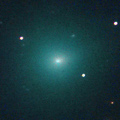
|
Now it is very bright as 10.8 mag (Nov. 2, Maik Meyer). It stays 11 mag until winter. It is observable in good condition in the Northern Hemisphere. It locates low in the Southern Hemisphere.
Date(TT) R.A. (2000) Decl. Delta r Elong. m1 Best Time(A, h)
Nov. 11 10 47.63 12 22.8 1.365 1.385 69 11.2 5:03 (296, 50)
Nov. 18 11 10.68 11 0.8 1.336 1.384 71 11.2 5:09 (300, 51)
|
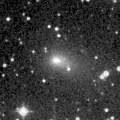
|
Now it is 12.8 mag (Oct. 30, Chris Wyatt). It will stay bright as 11 mag for a long time from winter to next spring. In the Southern Hemisphere, it stays observable in good condition until next February. In the Northern Hemispehre, it stays observable for a long time after this until the comet fades out.
Date(TT) R.A. (2000) Decl. Delta r Elong. m1 Best Time(A, h)
Nov. 11 5 24.25 1 53.6 2.366 3.207 142 11.9 2:05 ( 0, 57)
Nov. 18 5 18.07 3 2.7 2.273 3.166 149 11.8 1:31 ( 0, 58)
|

|
It brightened up to 7.1 mag from May to June (June 21, Juan Jose Gonzalez). Now it is fading. It has already faded down to 12.2 mag (Oct. 19, Chris Wyatt). In the Southern Hemisphere, it stays observable for a long time after this. It will never be observable again in the Northern Hemisphere.
Date(TT) R.A. (2000) Decl. Delta r Elong. m1 Best Time(A, h)
Nov. 11 18 26.74 -56 55.5 2.987 2.544 54 12.0 18:24 ( 25,-11)
Nov. 18 18 49.44 -57 3.6 3.092 2.608 52 12.2 18:20 ( 25,-11)
|

|
Now it is bright as 12.9 mag (Oct. 26, Seiichi Yoshida).
Date(TT) R.A. (2000) Decl. Delta r Elong. m1 Best Time(A, h)
Nov. 11 21 8.75 -14 13.4 5.780 5.809 86 13.5 18:24 ( 12, 40)
Nov. 18 21 11.19 -14 0.1 5.891 5.808 80 13.6 18:20 ( 19, 39)
|
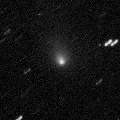
|
It brightened very rapidly from July to August. Now it is very bright as 14.2 mag (Nov. 8, Chris Wyatt). It is observable in excellent condition in the Southern Hemisphere. It stays low for a while in the Northern Hemisphere.
Date(TT) R.A. (2000) Decl. Delta r Elong. m1 Best Time(A, h)
Nov. 11 23 52.22 -32 11.1 2.011 2.558 112 13.8 20:29 ( 0, 23)
Nov. 18 23 52.03 -30 40.7 2.056 2.531 107 13.7 20:02 ( 0, 25)
|
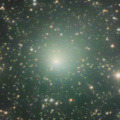
|
It brightened up to 10 mag from spring to summer. Now it is fading. It has already faded down to 13.2 mag (Nov. 7, Thomas Lehmann). It is observable in excellent condition in the Southern Hemisphere. It locates low in the Northern Hemisphere.
Date(TT) R.A. (2000) Decl. Delta r Elong. m1 Best Time(A, h)
Nov. 11 20 50.11 -27 45.9 1.942 2.004 78 14.0 18:24 ( 14, 26)
Nov. 18 21 5.24 -26 21.6 2.047 2.041 75 14.3 18:20 ( 16, 27)
|
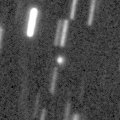
|
Now it is 13.7 mag (Sept. 22, Sandor Szabo). It is expected to brighten up to 12 mag from 2018 to 2019. In the Northern Hemisphere, it stays observable in good condition while the comet will be brightening gradually. In the Southern Hemisphere, it is not observable until 2018 October.
Date(TT) R.A. (2000) Decl. Delta r Elong. m1 Best Time(A, h)
Nov. 11 15 12.49 47 8.5 4.000 3.684 64 14.4 18:24 (134, 20)
Nov. 18 15 16.63 47 16.8 3.916 3.638 66 14.3 5:09 (227, 22)
|
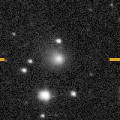
|
Now it is 14.4 mag (Oct. 9, Yasukazu Ikari). It is expected to brighten up to 10 mag in summer in 2018. In the Northern Hemisphere, it stays observable until 2018 summer while the comet will be brightening. However, it will be extremely low from December to January. In the Southern Hemisphere, it is hardly observable in 2017, but it will be observable in good condition in 2018.
Date(TT) R.A. (2000) Decl. Delta r Elong. m1 Best Time(A, h)
Nov. 11 17 30.86 17 52.0 4.256 3.704 50 14.5 18:24 ( 91, 31)
Nov. 18 17 36.52 16 14.6 4.255 3.648 46 14.4 18:20 ( 92, 27)
|
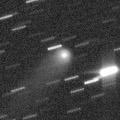
|
Now it is 13.6 mag (Oct. 23, T. Ikemura, H. Sato). It will be observable at 14 mag for a long time from 2017 to 2018. In the Southern Hemisphere, it will be hardly observable after this. It will be extremely low from November to December in the Northern Hemisphere.
Date(TT) R.A. (2000) Decl. Delta r Elong. m1 Best Time(A, h)
Nov. 11 16 13.83 18 57.7 4.538 3.834 40 14.7 18:24 (102, 16)
Nov. 18 16 16.25 19 7.6 4.528 3.820 39 14.6 18:20 (105, 12)
|
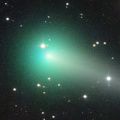
|
It brightened up to 6.2 mag in April (Apr. 7, Juan Jose Gonzalez). Now it is fading rapidly. It has already faded down to 13.6 mag (Oct. 17, Thomas Lehmann). It stays observable for a long time after this.
Date(TT) R.A. (2000) Decl. Delta r Elong. m1 Best Time(A, h)
Nov. 11 3 10.01 18 42.5 1.893 2.883 178 14.8 23:46 ( 0, 74)
Nov. 18 3 2.92 18 0.8 1.980 2.963 172 15.1 23:12 ( 0, 73)
|
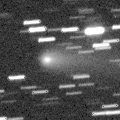
|
It brightened up to 12.2 mag in August (Aug. 21, Juan Jose Gonzalez). It is fading now. It has already faded down to 14.0 mag (Oct. 1, Michael Jager).
Date(TT) R.A. (2000) Decl. Delta r Elong. m1 Best Time(A, h)
Nov. 11 8 19.36 9 58.4 1.376 1.874 103 14.8 4:59 ( 0, 65)
Nov. 18 8 21.54 10 10.1 1.354 1.931 110 15.0 4:34 ( 0, 65)
|
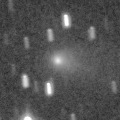
|
Now it is 15.0 mag (Oct. 30, D. Buczynski). It brightened rapidly. It is observable at 15 mag in autumn in good condition in the Northern Hemisphere. It locates low in the Southern Hemisphere.
Date(TT) R.A. (2000) Decl. Delta r Elong. m1 Best Time(A, h)
Nov. 11 5 41.42 36 41.9 1.146 2.011 140 15.0 2:22 (180, 88)
Nov. 18 5 38.72 37 46.3 1.130 2.032 146 15.0 1:52 (180, 87)
|
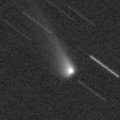
|
Now it is 14.4 mag (Oct. 27, Catalina Sky Survey). It stays observable at 15-16 mag for a long time from 2017 to 2018.
Date(TT) R.A. (2000) Decl. Delta r Elong. m1 Best Time(A, h)
Nov. 11 0 45.07 10 18.1 3.425 4.278 145 15.0 21:22 ( 0, 65)
Nov. 18 0 37.07 8 22.5 3.507 4.274 136 15.0 20:46 ( 0, 63)
|
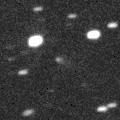
|
Now it is 16.6 mag (Oct. 11, Catalina Sky Survey). It will approach to Earth down to 0.2 a.u., and to Sun down to 0.6 a.u., and it is expected to brighten up to 9 mag from winter to spring. In the Northern Hemisphre, it stays observable in good condition until January, but it will be extremely low after that. In the Southern Hemisphere, it is not observable from January to mid March, but it stays observable in good condition except for that period.
Date(TT) R.A. (2000) Decl. Delta r Elong. m1 Best Time(A, h)
Nov. 11 8 48.87 -3 57.7 1.683 1.989 92 15.6 5:03 (350, 51)
Nov. 18 8 52.60 -3 30.6 1.470 1.887 98 15.1 5:05 ( 0, 51)
|
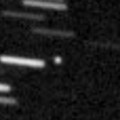
|
Now it is 16.4 mag (Oct. 29, Katsumi Yoshimoto). It will approach to Earth down to 0.07 a.u. in mid December, and it will brighten up to 10 mag. In the Northern Hemisphere, it stays observable in excellent condition until mid December. In the Southern Hemisphere, it stays low.
Date(TT) R.A. (2000) Decl. Delta r Elong. m1 Best Time(A, h)
Nov. 11 7 5.74 35 12.8 0.704 1.501 123 15.8 3:46 (180, 90)
Nov. 18 7 5.74 36 0.7 0.562 1.420 130 15.2 3:19 (180, 89)
|
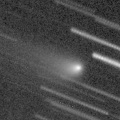
|
Now it is 15.9 mag (Oct. 9, T. Ikemura, H. Sato). It will be fading after this.
Date(TT) R.A. (2000) Decl. Delta r Elong. m1 Best Time(A, h)
Nov. 11 19 5.06 -16 29.8 3.237 2.828 57 15.2 18:24 ( 44, 26)
Nov. 18 19 4.43 -17 6.2 3.381 2.849 50 15.3 18:20 ( 48, 22)
|
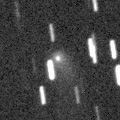
|
Now it is 13.7 mag (Oct. 13, Juan Jose Gonzalez). In the Northern Hemisphere, it stays 15 mag until winter, and it is observable in excellent condition. It is not observable at all after this in the Southern Hemisphere.
Date(TT) R.A. (2000) Decl. Delta r Elong. m1 Best Time(A, h)
Nov. 11 19 49.90 64 53.3 2.952 3.243 98 15.4 18:24 (159, 55)
Nov. 18 19 46.99 63 55.4 2.995 3.255 96 15.4 18:20 (154, 54)
|

|
Now it is 15.6 mag (Oct. 25, Yasukazu Ikari). It stays 17 mag in 2018.
Date(TT) R.A. (2000) Decl. Delta r Elong. m1 Best Time(A, h)
Nov. 11 3 27.01 -0 38.5 5.229 6.175 161 15.5 0:08 ( 0, 54)
Nov. 18 3 24.42 -0 53.6 5.266 6.204 159 15.5 23:33 ( 0, 54)
|
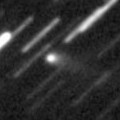
|
Now it is 14.7 mag (Nov. 8, Chris Wyatt). It stays 15 mag until winter. In the Southern Hemisphere, it stays observable in excellent condition until spring in 2018. In the Northern Hemisphere, it stays unobservable until 2018.
Date(TT) R.A. (2000) Decl. Delta r Elong. m1 Best Time(A, h)
Nov. 11 1 33.27 -73 32.2 1.892 2.103 87 15.6 22:09 ( 0,-18)
Nov. 18 1 27.78 -70 39.3 1.871 2.079 87 15.5 21:37 ( 0,-15)
|
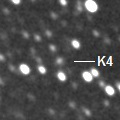
|
Now it is 15.0 mag (Oct. 10, T. Ikemura, H. Sato). It stays 16 mag for a long time until summer in 2018. It will be unobservable from winter to spring.
Date(TT) R.A. (2000) Decl. Delta r Elong. m1 Best Time(A, h)
Nov. 11 18 41.95 -23 47.9 3.222 2.711 51 15.9 18:24 ( 43, 17)
Nov. 18 18 54.74 -23 2.2 3.273 2.697 46 15.9 18:20 ( 46, 16)
|

|
Now it is 16.7 mag (Nov. 2, A. Diepvens). It will be observable at 15 mag in good condition from winter to spring.
Date(TT) R.A. (2000) Decl. Delta r Elong. m1 Best Time(A, h)
Nov. 11 11 18.87 10 47.0 3.896 3.547 62 16.0 5:03 (291, 43)
Nov. 18 11 25.66 10 15.3 3.801 3.545 67 15.9 5:09 (297, 48)
|
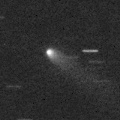
|
Now it is 15.7 mag (Oct. 30, Catalina Sky Survey). It will be fading after this, and it will be fainter than 18 mag in March.
Date(TT) R.A. (2000) Decl. Delta r Elong. m1 Best Time(A, h)
Nov. 11 0 59.38 17 28.2 2.051 2.951 150 16.0 21:36 ( 0, 73)
Nov. 18 0 56.52 17 19.4 2.114 2.963 142 16.1 21:06 ( 0, 72)
|

|
Appearing in the morning sky. It stays 16-17 mag for a long time from 2016 to 2019. It stays near by the equator.
Date(TT) R.A. (2000) Decl. Delta r Elong. m1 Best Time(A, h)
Nov. 11 10 27.63 4 5.1 9.831 9.563 71 16.1 5:03 (310, 48)
Nov. 18 10 29.49 4 0.1 9.720 9.564 78 16.1 5:09 (320, 52)
|
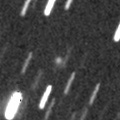
|
Now it is 17.1 mag (Oct. 27, Yuji Ohshima). It stays observable at 16 mag for a long time until summer in 2018. It is observable in good condition in the Northern Hemisphere in 2017, and in the Southern Hemisphere in 2018.
Date(TT) R.A. (2000) Decl. Delta r Elong. m1 Best Time(A, h)
Nov. 11 4 3.57 65 26.6 1.332 2.116 130 16.4 0:49 (180, 60)
Nov. 18 2 31.02 64 42.7 1.248 2.056 133 16.1 22:33 (180, 60)
|
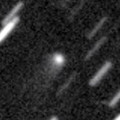
|
Now it is 16.4 mag (Oct. 26, Purple Mountain Observatory, XuYi Station). It stays 16 mag for a long time from 2017 to 2018. It is observable in excellent condition in the Northern Hemisphere. It locates very low in the Southern Hemisphere.
Date(TT) R.A. (2000) Decl. Delta r Elong. m1 Best Time(A, h)
Nov. 11 9 17.04 24 2.8 5.164 5.329 94 16.3 5:03 (310, 74)
Nov. 18 9 15.68 25 6.3 5.038 5.328 101 16.3 5:09 (336, 79)
|
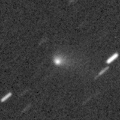
|
Now it is 15.9 mag (Nov. 2, ATLAS-HKO, Haleakala). Return of a new periodic comet which brightened up to 13 mag in 2004. It will be observable in excellent condition in autumn. It was expected to brighten up to 14 mag, if the comet is as bright as when it was discovered. But actually, it is much fainter than expected.
Date(TT) R.A. (2000) Decl. Delta r Elong. m1 Best Time(A, h)
Nov. 11 2 23.68 10 33.8 0.757 1.738 168 16.5 23:00 ( 0, 66)
Nov. 18 2 19.37 11 56.9 0.785 1.749 160 16.6 22:28 ( 0, 67)
|
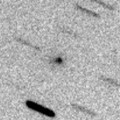
|
Now it is 17.2 mag (Nov. 2, A. Diepvens). It stays observable at 17 mag in good condition for a while. It will be fainter than 18 mag in May.
Date(TT) R.A. (2000) Decl. Delta r Elong. m1 Best Time(A, h)
Nov. 11 12 39.37 0 55.3 2.670 2.016 40 16.6 5:03 (285, 22)
Nov. 18 12 53.90 -0 18.1 2.642 2.039 43 16.6 5:09 (289, 25)
|
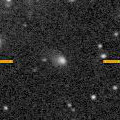
|
Now it is 16.4 mag (Oct. 26, D. Buczynski). It is expected to brighten up to 13-14 mag from 2018 to 2019. In the Northern Hemisphere, it stays observable in good condition for a long time. In the Southern Hemisphere, it is not observable until summer in 2018.
Date(TT) R.A. (2000) Decl. Delta r Elong. m1 Best Time(A, h)
Nov. 11 18 31.51 48 20.3 5.183 5.109 80 16.7 18:24 (126, 52)
Nov. 18 18 34.62 46 50.7 5.182 5.063 77 16.6 18:20 (123, 48)
|
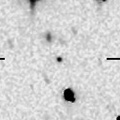
|
Now it is 16.6 mag (Oct. 24, Catalina Sky Survey). It will be observable at 16.5 mag in good condition in winter.
Date(TT) R.A. (2000) Decl. Delta r Elong. m1 Best Time(A, h)
Nov. 11 9 36.69 0 25.0 2.684 2.735 82 16.7 5:03 (330, 51)
Nov. 18 9 42.85 -1 20.1 2.618 2.754 87 16.7 5:09 (341, 52)
|
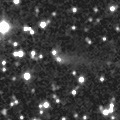
|
Now it is 16.9 mag (Nov. 2, A. Diepvensy). In the Northern Hemisphere, it will be observable at 17 mag in excellent condition from autumn to winter. It locates low in the Southern Hemisphere.
Date(TT) R.A. (2000) Decl. Delta r Elong. m1 Best Time(A, h)
Nov. 11 5 42.38 34 58.8 2.316 3.145 140 16.7 2:23 ( 0, 90)
Nov. 18 5 39.27 35 21.6 2.280 3.161 147 16.7 1:52 (180, 90)
|

|
Now it is 16.1 mag (Oct. 29, N. James). It stays 16 mag from 2016 to 2017. In the Northern Hemisphere, it stays observable in good condition for a long time. In the Southern Hemisphere, it will never be observable again.
Date(TT) R.A. (2000) Decl. Delta r Elong. m1 Best Time(A, h)
Nov. 11 18 31.86 59 28.0 6.620 6.652 87 16.8 18:24 (143, 50)
Nov. 18 18 40.37 59 10.5 6.644 6.669 87 16.9 18:20 (142, 48)
|
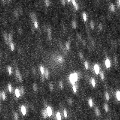
|
It brightened up to 13.5 mag in July (July 5, Chris Wyatt). But it is fading after that, even before the perihelion passage. It has already faded down to 16.8 mag (Oct. 29, ATLAS-MLO, Mauna Loa). It is observable in excellent condition in the Southern Hemisphere. It locates somewhat low in the Northern Hemisphere.
Date(TT) R.A. (2000) Decl. Delta r Elong. m1 Best Time(A, h)
Nov. 11 20 34.22 -14 2.8 1.960 2.018 78 16.9 18:24 ( 22, 38)
Nov. 18 20 47.51 -12 52.7 2.041 2.028 75 17.0 18:20 ( 26, 38)
|
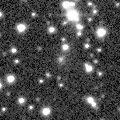
|
Now it is 16.7 mag (Oct. 25, Ken-ichi Kadota). It will pass the perihelion in 2019. However, it has not been brightening since the discovery in 2010. It is observable in good conditioin in the Northern Hemisphere. It is not observable for a long time in the Southern Hemisphere.
Date(TT) R.A. (2000) Decl. Delta r Elong. m1 Best Time(A, h)
Nov. 11 7 3.61 73 18.9 8.428 8.893 115 16.9 3:45 (180, 52)
Nov. 18 7 1.51 73 59.1 8.367 8.880 118 16.9 3:15 (180, 51)
|
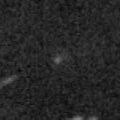
|
Now it is 18.5 mag (Oct. 21, Jonathan L. Tuten, D. Breedlove, B. Lutkenhoner). Appearing in the morning sky. It will be fading slowly after this.
Date(TT) R.A. (2000) Decl. Delta r Elong. m1 Best Time(A, h)
Nov. 11 11 26.96 -7 36.8 3.028 2.570 53 17.0 5:03 (305, 29)
Nov. 18 11 34.26 -8 36.6 3.001 2.626 58 17.1 5:09 (312, 33)
|
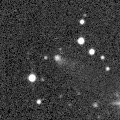
|
Now it is 18.1 mag (Oct. 25, D. Buczynski). It is observable in good condition in the Northern Hemisphere. It locates very low in the Southern Hemisphere.
Date(TT) R.A. (2000) Decl. Delta r Elong. m1 Best Time(A, h)
Nov. 11 7 28.76 35 5.7 2.508 3.113 119 17.1 4:09 (180, 90)
Nov. 18 7 28.57 35 29.4 2.452 3.137 126 17.1 3:41 (180, 90)
|

|
Now it is 16.6 mag (Sept. 16, P. Camilleri, H. Williams). It will brighten up to 14 mag from autumn to winter in 2018, and it will be observable in excellent condition in the Northern Hemisphere. In 2017, it is observable at 17 mag in excellent condition in the Southern Hemisphere.
Date(TT) R.A. (2000) Decl. Delta r Elong. m1 Best Time(A, h)
Nov. 11 22 57.55 -39 45.0 3.369 3.658 99 17.1 19:35 ( 0, 15)
Nov. 18 22 56.37 -38 16.6 3.417 3.614 93 17.1 19:06 ( 0, 17)
|

|
Now it is 17.3 mag (Oct. 22, C. Rinner, F. Kugel). It will brighten up to 9 mag in 2018 summer. However, it is hardly observable when it is bright. In the Northern Hemisphere, it is observable only until March when it brightens up to 14 mag. In the Southern Hemisphere, it is observable from July to September in 2018, but it locates in extremely low.
Date(TT) R.A. (2000) Decl. Delta r Elong. m1 Best Time(A, h)
Nov. 11 21 31.03 73 53.0 3.281 3.716 108 17.3 18:24 (178, 51)
Nov. 18 21 36.82 71 43.1 3.202 3.637 108 17.1 18:20 (176, 53)
|
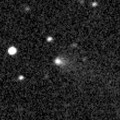
|
First return of a new periodic comet discovered in 2000. Now it is 15.9 mag (Oct. 29, Catalina Sky Survey). Although it has been brightening even after the perihelion passage, it will be fading after this.
Date(TT) R.A. (2000) Decl. Delta r Elong. m1 Best Time(A, h)
Nov. 11 0 26.20 -2 25.0 2.001 2.802 136 17.2 21:03 ( 0, 53)
Nov. 18 0 24.90 -1 26.8 2.093 2.826 129 17.4 20:34 ( 0, 54)
|
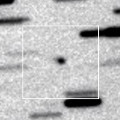
|
Now it is 16.6 mag (Oct. 26, Yuji Ohshima). It stays observable at 18 mag for a long time until 2019.
Date(TT) R.A. (2000) Decl. Delta r Elong. m1 Best Time(A, h)
Nov. 11 6 52.66 19 37.8 7.373 7.996 126 17.9 3:33 ( 0, 75)
Nov. 18 6 48.25 19 26.0 7.271 7.990 134 17.8 3:01 ( 0, 74)
|

|
Possible first interstellar object in the history. It approached to Sun down to 0.25 a.u. on Sept. 9. Now it is fading rapidly. It was 19.0 mag in mid October (Oct. 14, Catalina Sky Survey). But it has already fade down to 23.9 mag (Nov. 10, W. H. Ryan, E. V. Ryan).
Date(TT) R.A. (2000) Decl. Delta r Elong. m1 Best Time(A, h)
Nov. 11 23 21.77 6 1.0 0.993 1.755 124 24.2 19:59 ( 0, 61)
Nov. 18 23 17.80 6 22.6 1.251 1.912 116 24.9 19:27 ( 0, 61)
|
|
![]()
 C/2017 T3 ( ATLAS )
C/2017 T3 ( ATLAS ) 352P/2017 L1 ( Skiff )
352P/2017 L1 ( Skiff ) C/2015 XY1 ( Lemmon )
C/2015 XY1 ( Lemmon ) A/2017 U1
A/2017 U1![]()







































